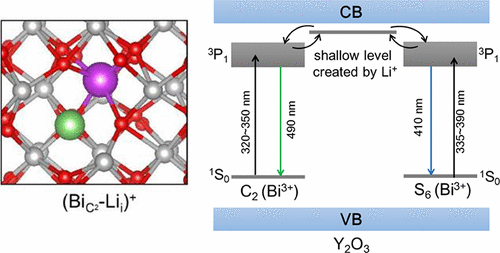Unexpected Roles of Interstitially Doped Lithium in Blue and Green Light Emitting Y2O3:Bi3+: A Combined Experimental and Computational Study
슈퍼관리자
2021-05-21
Unexpected Roles of Interstitially Doped Lithium in Blue and Green Light Emitting Y2O3:Bi3+: A Combined Experimental and Computational Study
-
Authors :
Sovann Khan, Heechae Choi, Seung Yong Lee, Kwang-Ryeol Lee, Odireleng Martin Ntwaeaborwa, Seungchul Kim, So-Hye Cho
-
Journal :
Inorganic Chem.
-
Vol :
56
-
Page :
12139-12147
-
Year :
2017

Abstract
To enhance the photoluminescence of lanthanide oxide, a clear understanding of its defect chemistry is necessary. In particular, when yttrium oxide, a widely used phosphor, undergoes doping, several of its atomic structures may be coupled with point defects that are difficult to understand through experimental results alone. Here, we report the strong enhancement of the photoluminescence (PL) of Y2O3:Bi3+ via codoping with Li+ ions and suggest a plausible mechanism for that enhancement using both experimental and computational studies. The codoping of Li+ ions into the Y2O3:Bi3+ phosphor was found to cause significant changes in its structural and optical properties. Interestingly, unlike previous reports on Li+ codoping with several other phosphors, we found that Li+ ions preferentially occupy interstitial sites of the Y2O3:Bi3+ phosphor. Computational insights based on density functional theory calculations also indicate that Li+ is energetically more stable in the interstitial sites than in the substitutional sites. In addition, interstitially doped Li+ was found to favor the vicinity of Bi3+ by an energy difference of 0.40 eV in comparison to isolated sites. The calculated DOS showed the formation of a shallow level directly above the unoccupied 6p orbital of Bi3+ as the result of interstitial Li+ doping, which may be responsible for the enhanced PL. Although the crystallinity of the host materials increased with the addition of Li salts, the degree of increase was minimal when the Li+ content was low (<1 mol %) where major PL enhancement was observed. Therefore, we reason that the enhanced PL mainly results from the shallow levels created by the interstitial Li+.















